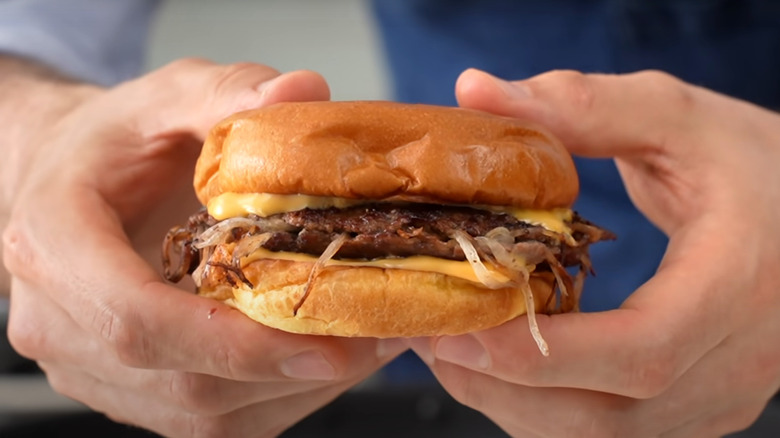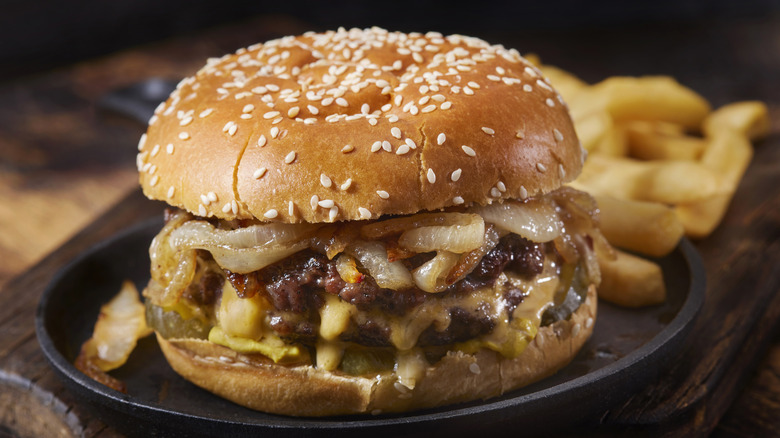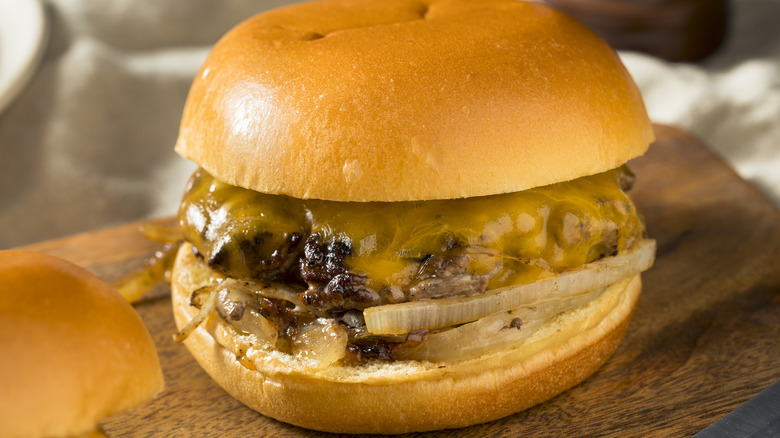The Oklahoma Onion Burger Was Created Out Of Necessity
Order a burger in Oklahoma City or the nearby town of El Reno, and you're likely to receive a delicious creation that piles a mountain of grilled onions onto a beef patty. The Oklahoma onion burger has been a staple for decades, originating from the harsh economic realities of the Great Depression beginning in 1929 (it's often called a Depression burger because of this).
During this time, beef skyrocketed in price. Simultaneously, the dust storms that plagued Oklahoma during the Dust Bowl caused many crops to fail, although onions were hardy enough to stay cheap and viable to grow. Noticing this, El Reno local Ross Davis, owner of the Hamburger Inn, devised a technique to cut down on costs by combining onions with beef for his burgers. Doing so stretched the meal further as it made the burger look bigger, even with less meat, and the product was delicious.
Davis made the burgers by smashing down a small beef patty with onions placed on top of the raw meat. After the bottom side was browned, the whole thing was flipped to finish cooking with the onion side down. Today, a slice of American cheese is often added. Also, rather than griddling the buns, the bread is often steamed next to the onions to pick up some of the allium's aroma.
This technique is still used at restaurants in the Sooner State and beyond, showing how a few humble ingredients can become a classic dish.
Where to eat onion burgers today
The onion burger traveled quickly from its birthplace at the Hamburger Inn to other El Reno, Oklahoma-based restaurants. Although the Inn is no longer open, three spots in town have been cooking Depression burgers for decades. Each establishment makes the same old-school-style onion burgers, with minor differences in how charred the onions get, or how thick the patty is.
The oldest is Robert's Grill, which has been flipping burgers since 1926. Fans of the restaurant are quick to note how its atmosphere has remained unchanged over the years. Next came Johnny's Hamburgers & Coneys, which opened its doors in 1946. The trifecta of El Reno onion burgers came in 1989 when a former Johnny's employee founded Sid's Dinner. The latter restaurant has become the most famous of the three, appearing in a 2015 episode of The Food Network's "Top Five Restaurants." In fact, onion burger culture remains so integral to El Reno that the city hosts an annual Burger Day Festival to celebrate its signature food.
Oklahoma City — about a half-hour drive east of El Reno — has its own share of onion burger landmarks, too. Tucker's Onion Burgers is a small chain with four locations in and around OKC, with an atmosphere steeped in the 1950s. The legendary burger's reach doesn't stop there, however. The onion burger has become a nationally known style and is served in restaurants from the Gotham Burger Social Club in New York to Lovely's Oakland in the Bay Area.
The anatomy of a great onion burger
If you want to make an onion burger at home, it pays to focus on each of its humble ingredients. This starts with the beef, which should be a fatty 80/20 blend (the same ratio you'd use for the perfect juicy all-beef burgers). An onion burger patty gets smashed thin, so you need a good amount of fat to keep it from drying out. Use about 2 ounces of beef per patty; anything more risks overwhelming the onions.
Next up are the onions, and we're talking a significant quantity. Aim for upwards of half a bulb per burger. They should also be sliced paper-thin, whether by hand or on a mandoline. The onions need to brown quickly in the time it takes the burger to finish cooking, and thicker pieces will take too long. Slice the onions from pole to pole for this task so the alliums aren't overly sharp. Remember, you're not looking for fully caramelized onions here; you just need to cook them until they're soft and have some color.
These burgers are a great option to make in a cast-iron skillet. Restaurants use flat-top griddles for the task, and cast iron offers a decent approximation thanks to its surface area and heat retention. It's commonly finished with American cheese for its superior melting qualities, unobtrusive taste, and ability to secure the onions in place. Most Oklahoma burgers keep the toppings simple — usually just pickles, mayo, and mustard.



